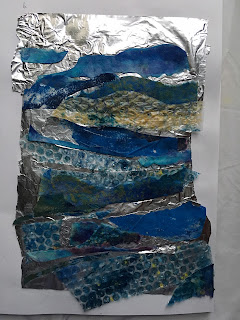The idea is to densely cover small spaces of fabric [about 3cms] using words describing different effects of rhythms to inform the stitching, especially those inspired by my drawings in chapter 1.
I've done a quick brainstorm of words and sketched some drawings below to represent those that spring to mind and posted my sketchbook page below.
I'll talk about each of the samples individually as I go.
I've worked on calico which I've stretched in an embroidery hoop and have used a size 100 needle throughout.
Sample 1 Straight stitch using a polyester machine sewing thread. Equal tensions on upper and lower bobbins
Sample 2
Straight stitch with whip stitch which is achieved by tightening the upper tension and loosening the lower bobbin.
I used polyester sewing threads, blue thread on top bobbin and yellow below. Top tension slightly tightened and lower bobbin tension loosened.
I keep a separate bobbin case especially for whip stitch so I can fiddle with the tension without jeopardising the one I use for normal sewing.
I changed over the colours half way down [my bobbin thread ran out!] but it was good to see the difference.
I've always loved whip stitch and it's serendipitous qualities and textures. Lovely subtle, soft and calm effects in this sample.
Sample 3
Zig zag stitch with whip stitch [bobbin tensions as above] and polyester sewing thread. Red on top bobbin and blue below [ reversed half way down]. Wonderful dramatic contrasts and textural effects.
Sample 4
Part straight stitch, part zigzag but this is cable stitch which means that the underside becomes the right side and brings some lovely unexpected results when turned over to reveal the stitching below.
Polyester thread. I've adjusted the upper tension [lower tension normal] as I worked to give varied effects. Blue thread on top bobbin and red below.
I've added the upper [wrong side] too as this was also lovely and interesting to look at.
Sample 5
Cable stitch worked with a range of threads on the lower bobbin. The tension of the lower bobbin was loosened according to the effect I was hoping for. Polyester sewing thread used on top throughout.
Top row. From left: a. no lower bobbin tension [screw removed] with stranded cotton and straight stitch.
Lovely dense and textured effect although my sewing machine not happy!;
b and c. Stranded cotton and straight stitch
Row 2: a. Stranded cotton and straight stitch. b. zigzag c. tapestry wool, slight zigzag stitch
Row 3: a. Boucle yarn and zigzag b. tapestry wool and straight stitch c. with zigzag
Row 4: a. Mohair yarn with zigzag b. and c. tapestry wool and zigzag
Row 5: a. and b. Cotton yarn with zigzag c. straight stitch
I love the wonderful textures achieved with cable stitch and shadows resulting from the build up of stitching gives interesting contrasting effects.
I also tried using a chenille yarn but my machine wouldn't tolerate the thickness of the yarn even with the loosest bobbin tension
A very enjoyable chapter and I look forward to applying the stitching to fabrics in later chapters.

































































